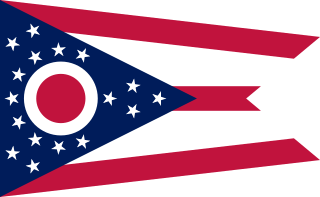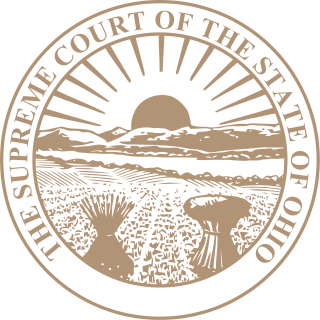
Ohio is a state in the Midwestern region of the United States. Ohio borders Lake Erie to the north, Pennsylvania to the east, West Virginia to the southeast, Kentucky to the southwest, Indiana to the west, and Michigan to the northwest. Of the 50 U.S. states, it is the 34th-largest by area. With a population of nearly 11.8 million, Ohio is the seventh-most populous and tenth-most densely populated state. Its capital and largest city is Columbus, with other large population centers including Cleveland, Cincinnati, Dayton, Akron, and Toledo. Ohio is nicknamed the "Buckeye State" after its Ohio buckeye trees, and Ohioans are also known as "Buckeyes". Its flag is the only non-rectangular flag of all U.S. states.

Robert Alphonso Taft III is an American politician and attorney who served as the 67th governor of Ohio from 1999 to 2007. A member of the Taft political dynasty and Republican Party, Taft previously served in the Ohio House of Representatives, then as Hamilton County commissioner, and as Ohio Secretary of State under governor George Voinovich.

Theodore Strickland is an American former politician who served as the 68th governor of Ohio from 2007 to 2011. A member of the Democratic Party, he previously served in the United States House of Representatives, representing Ohio's 6th congressional district.

John Kenneth Blackwell is an American politician, author, and conservative activist who served as the mayor of Cincinnati, Ohio (1979–1980), the Ohio State Treasurer (1994–1999), and Ohio Secretary of State (1999–2007). He was the Republican candidate for governor of Ohio in 2006, the first African-American major-party candidate for governor of Ohio. He is currently a Senior Fellow for Family Empowerment with The Family Research Council. He currently sits as Vice-President of the Executive Committee of the Council For National Policy and is a member of the Council on Foreign Relations.

Bruce Edward Johnson is an American lawyer and Republican politician who was appointed the State of Ohio's 63rd lieutenant governor on January 5, 2005, to complete an unexpired term. Johnson concurrently served as Director of the Ohio Department of Development.
The University System of Ohio is the public university system of the U.S. state of Ohio. It is governed by the Ohio Department of Higher Education.

The economy of Ohio nominally would be the 20th largest global economy behind Turkey and ahead of Switzerland according to The World Bank as of 2022. The state had a GDP of $822.67 billion in 2022, which is 3.23% of the United States total, ranking 7th in the nation behind Pennsylvania and ahead of Georgia. In 2013, Ohio was ranked in the top ten states for best business climate by Site Selection magazine, based on a business-activity database. The state was edged out only by Texas and Nebraska for the 2013 Governor's Cup award from the magazine, based on business growth and economic development.

DeRolph v. State is a landmark case in Ohio constitutional law in which the Supreme Court of Ohio ruled that the state's method for funding public education was unconstitutional. On March 24, 1997, the Supreme Court of Ohio ruled in a 4–3 decision that the state funding system "fails to provide for a thorough and efficient system of common schools," as required by the Ohio Constitution, and directed the state to find a remedy. The court would look at the case several times over the next 12 years before it relinquished jurisdiction, but the underlying problems with the school funding system remain to this day.
Education in Ohio is provided by both public and private schools, colleges, and universities. Ohio's system of public education is outlined in Article VI of the state constitution, and in Title XXXIII of the Ohio Revised Code. Ohio University, the first university in the Northwest Territory, was also the first public institution in Ohio. Substantively, Ohio's system is similar to those found in other states. At the State level, the Ohio Department of Education, which is overseen by the Ohio State Board of Education, governs primary and secondary educational institutions. At the municipal level, there are approximately 700 school districts statewide. The Ohio Board of Regents coordinates and assists with Ohio's institutions of higher education which have recently been reorganized into the University System of Ohio under Governor Strickland. The system averages an annual enrollment of more than 400,000 students, making it one of the five largest state university systems in the U.S.

Jack Cleveland Casino is a casino in the downtown core of Cleveland, Ohio, United States, owned by Vici Properties and operated by Jack Entertainment.

Hollywood Casino Columbus is a casino located in Columbus, Ohio. It opened on October 8, 2012 and is owned by Gaming and Leisure Properties and operated by Penn Entertainment.

Ohio is home to many professional and college sports teams. The metropolitan areas of Cleveland, Cincinnati, and Columbus are home to major league professional sports teams in baseball, basketball, football, hockey, and soccer.
The Ohio State Sports Network from Learfield is an American radio network consisting of 62 radio stations which carry coverage of Ohio State Buckeyes football and men's basketball. Co-owned WBNS and WBNS-FM, both licensed to Columbus, Ohio, serve as the network's 2 flagship stations. The network also includes 60 affiliates in the U.S. states of Ohio and West Virginia: 33 AM stations, 22 of which extend their signals with low-power FM translators; 26 full-power FM stations; and one HD Radio digital subchannel which supplements its signal with a low-power FM translator. Paul Keels has served as play-by-play announcer for both football and men's basketball since 1998; former Ohio State offensive guard Jim Lachey currently serves as color analyst for football; and former Ohio State point guard Ron Stokes currently serves as color analyst for men's basketball.

Cannabis in Ohio is legal for recreational use. Issue 2, a ballot measure to legalize recreational use, passed by a 57–43 margin on November 7, 2023. Possession and personal cultivation of cannabis became legal on December 7, 2023, with the first licensed sales yet to occur under the law. Prior to legalization, Ohio decriminalized possession of up 100 grams in 1975, with several of the state's major cities later enacting further reforms.










